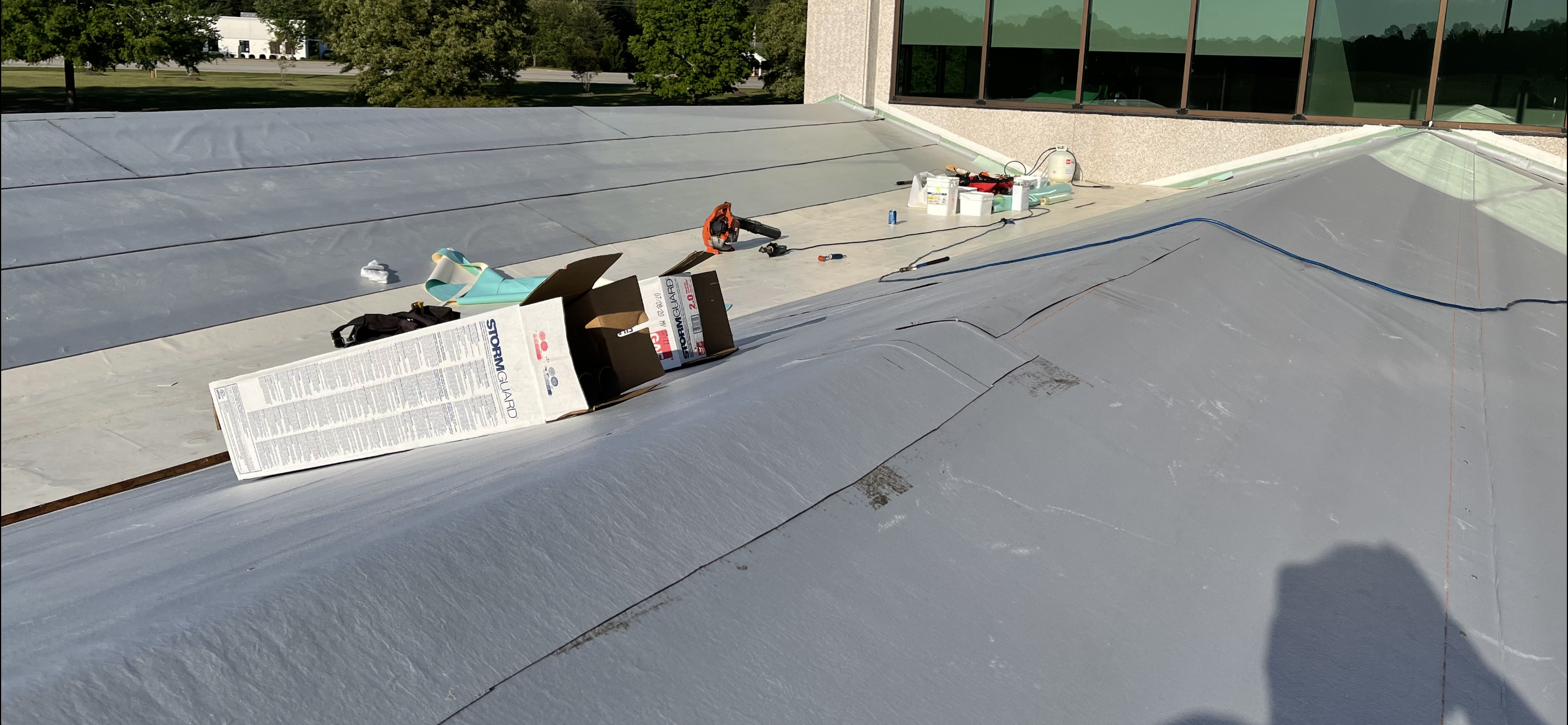
Your roof can only take so many quick fixes before it starts telling you the truth. If leaks return after every storm, shingles curl or shed granules, or the deck feels soft underfoot, repair may not cut it.
Replacing a few tabs works for small, isolated damage. But widespread wear, sagging areas, or an older roof near the 15–20 year mark point to bigger issues hiding under the surface. Watch for rising energy bills, musty attic smells, stained ceilings, and daylight peeking through the boards. Those signs suggest water is traveling beyond a simple patch.
A thorough inspection helps you compare the real costs: another short-term repair or a replacement that stops the cycle and protects your home. Knowing where that line sits saves money, stress, and your peace of mind.
At What Age Should a Roof Be Replaced Instead of Repaired?
Age isn’t everything, but it’s not nothing either. Think of roof age like the odometer on a car; it doesn’t tell you the whole story, but it sets the context for every decision.
- Asphalt shingles (the neighborhood classic): Many begin to show their age between 18–25 years depending on product line, ventilation, and climate. If your asphalt roof is pushing past its mid-20s and you’re chasing leaks? You’re living on borrowed time.
- Architectural/laminated shingles: These can stretch longer, especially with proper ventilation, but even they hit diminishing returns as sealants age, granules loosen, and the mat dries out.
- Metal, tile, and slate: Longer lifespans, but age still matters for flashings, underlayment, and fasteners—components that often fail before the “headline” material does.
Here’s the opinionated rule of thumb we use on-site: If your roof is in the last 15–20% of its expected lifespan and you’re facing anything more than a minor, isolated repair, you should strongly consider replacement. Why? Because materials age in clusters. Once shingle flexibility drops and granules thin, new problems don’t politely line up—they appear together.
Red flags tied to age:
- Curling or cupping shingles
- Widespread granule loss revealing bald spots
- Brittle shingles that crack when lightly bent
- Ridge and hip caps that look sunburned and fragile
Could a skilled crew still find and fix a small leak on an older roof? Absolutely. But on a roof at the end of its race, that fix is often a pause button, not a solution.
What Signs Indicate a Roof Needs Replacement Over Simple Repairs?
Visual cues are your early-warning radar. Some are obvious; others hide in plain sight. If your roof is sending any of these signals, it’s not being dramatic—it’s trying to tell you something.
- Leaks in multiple areas.
One ceiling stain after a windstorm might be a flashing hiccup. Three stains across different rooms? That’s a system talking, not a blemish. - Shingle fields losing shape.
When large areas look wavy, buckled, or uneven, you may be dealing with deck issues or widespread shingle fatigue, not just one bad square. - Matted granules in gutters and downspouts.
A little shedding after installation is normal; heavy, ongoing granule piles mean the UV armor coat is leaving the roof—aging is accelerating. - Persistent attic moisture.
Rusty nails, damp insulation, or a musty attic smell suggest ventilation problems or chronic leaks. Fixing a single shingle won’t cure a roof that can’t breathe. - Chronic flashing failures.
Chimneys, skylights, and wall-to-roof transitions are notorious. If flashings keep failing even after careful repairs, the surrounding materials (or installation history) may be working against you. - Storm damage that “overlaps.”
Hail, wind, and flying limbs can cause injuries in different roof zones. When the affected areas overlap across slopes and valleys, a patchwork repair starts looking like quilt-making on a cliff—technically possible, pragmatically risky.
Gut-check question: If you repaired every visible problem today, would you trust the roof to sail through the next two storm seasons? If your honest answer is no, that’s your sign.
How Does the Extent of Roof Damage Determine the Need For Replacement?
Imagine your roof as a layered orchestra: shingles, underlayment, flashing, deck, vents, and fasteners. If one violin squeaks, you fix the string. If half the strings are frayed, the conductor calls a reset.
Damage by “zones” and what they suggest:
- Isolated, single-source damage (e.g., one missing shingle, small puncture):
Repair is sensible and cost-effective—especially if the surrounding shingles are healthy and relatively young. - Multiple small leaks across different slopes:
This points to broader material fatigue, ventilation issues, or an aging underlayment in retreat. Replacing individual trouble spots becomes a game of whack-a-mole. - Compromised valleys and transitions:
Valleys carry water traffic. When their membranes, step flashings, or underlayment are failing, it often indicates systemic wear. Replacement of at least that slope—or the entire roof if age is high—becomes the safer move. - Decking damage (soft, spongy, or rotted):
If tear-off reveals widespread deck rot, repairs are like patching drywall over a broken stud—cosmetic, not structural. Decks are your foundation up there; if they’re failing in multiple areas, replacement is the grown-up choice. - Hail fields and bruise patterns:
With hail, the story is density and spread. A handful of bruised shingles? Repair. A field of impact marks across slopes, with obvious granule craters and soft spots underfoot? Replacement isn’t overkill; it’s prudence. - Wind uplift and seal failure:
When strips fail across an entire face (or several faces), shingles become prone to flapping, creasing, and tearing. You can resecure some—but once the adhesive is aged and the mat is fatigued, the bond won’t play ball.
A practical threshold: when 30%+ of a roof surface requires intervention—by count or area—replacement becomes the smarter trajectory, particularly for older roofs. The labor of piecemeal fixes can rival the labor of a clean, controlled re-roof, without the peace of mind.
Can Frequent Repairs Eventually Cost More Than a Total Roof Replacement?
Short answer: yes. Longer answer: it happens more often than people realize, because repairs hide in ordinary monthly budgets while replacements wear neon price tags.
Think of a roof like a car you love. New tires here, new alternator there—you’re “only” spending a few hundred at a time. But if the transmission is next, those little wins were just staging for the big bill. Roofs can follow the same script.
The hidden math of repair-first strategies:
- Trip charges add up.
Each visit carries overhead: inspection time, setup, safety gear, and cleanup. Four small visits can equal one major service. - Opportunity cost.
While you chase drips, energy losses from poor ventilation or degraded shingles nibble at your utility bills. Attic moisture can chew on insulation value, too. - Collateral damage.
Leaks don’t only stain ceilings. They degrade drywall, warp trim, and feed mold spores. That’s not a roofing line item—that’s a house line item. - Material mismatch.
On older roofs, new shingles don’t always mate cleanly with the aged field. Patches can look obvious and may fail earlier than the surrounding areas. - Insurance and resale.
A documented, warranted replacement is easier to explain to insurers and buyers than a trail of patch notes. It’s not just about cost; it’s about confidence.
A quick sanity check you can do:
- Add up your last 2–3 years of roof spend (inspections, emergency callouts, interior repairs).
- Add a conservative estimate for the next two years if nothing changes.
- Compare that to a full replacement that includes upgraded underlayment, balanced ventilation, and a strong warranty.
If the five-year repair path lands within striking distance of a replacement—and your roof is aging out—replacement usually wins on both dollars and quality of life.
The Real-World Scenarios We See (And What We Recommend)
- “My roof is 22 years old with two active leaks.”
You can repair, but the deck dice are rolling. Recommendation: replacement with a modern system (ice-and-water in vulnerable zones, proper intake/exhaust balance). Prevents the third leak and the fourth contractor visit. - “A limb punched a hole through one slope; the rest looks good.”
Isolated slope repair may be fine, especially for younger roofs. Still, check ventilation and flashings while you’re there. A half-day of diligence here avoids years of drip drama. - “We’ve had three flashings fail around the same chimney.”
That’s a symptom, not an accident. Rework the entire transition—step flashing, counterflashing, and underlayment and evaluate shingle age on that slope. Chronic failures mean the surrounding field isn’t holding its end of the bargain. - “Hail peppered the whole neighborhood.”
If bruise density and granule loss are widespread, replacement often pencils out, especially with insurance involved. Repairs will look like polka dots and won’t reset your warranty clock.
When Repair Still Makes Beautiful Sense
Let’s be fair: sometimes a repair is exactly right.
- Younger roof with a clear, single-source issue
- High-quality installation where one detail was compromised
- Budget timing—repair now with a planned replacement in 12–18 months
- Real estate timing—repair to disclose responsibly, price accordingly, and let the next owner choose their system
Pro tip: If you choose repair on an older roof, schedule a thorough attic/ventilation review at the same time. Small tweaks (like clearing blocked soffits) can stall aging and buy you real time, not false hope.
Ready to Choose With Confidence—Not Guesswork?
We’ll help you cut through the noise with a side-by-side plan you can actually trust
If you’re tired of guessingor tired of buckets, reach out to Eason Roofing. Let’s put data, experience, and a little common sense on your side so you can make the call with zero second-guessing and a roof that’s ready for the next decade, not just the next drizzle.





